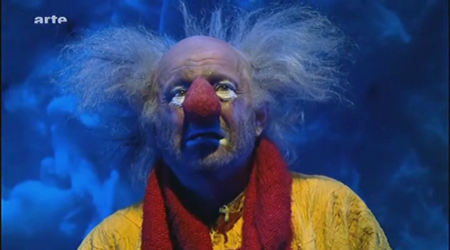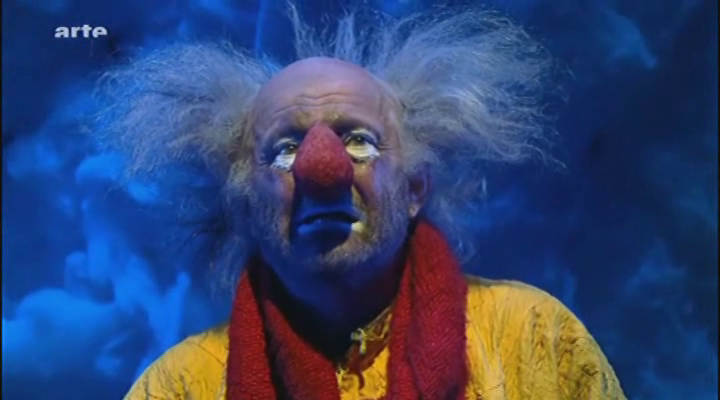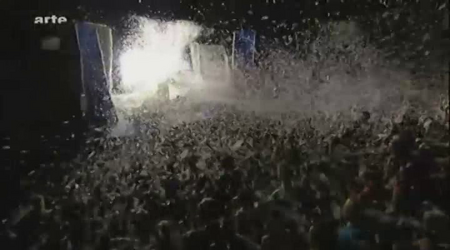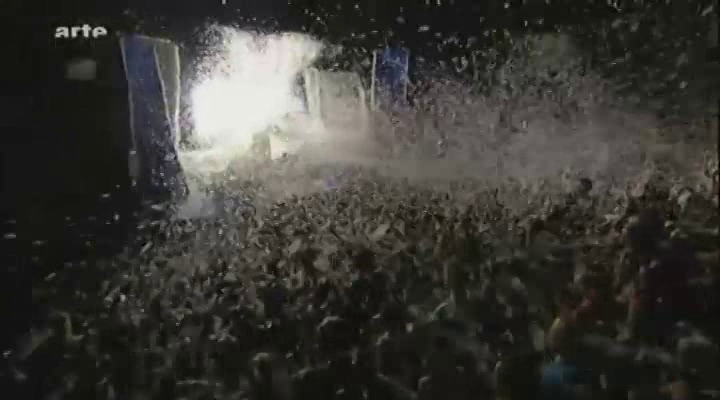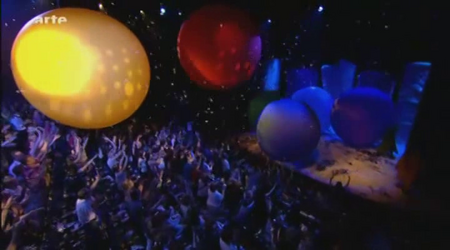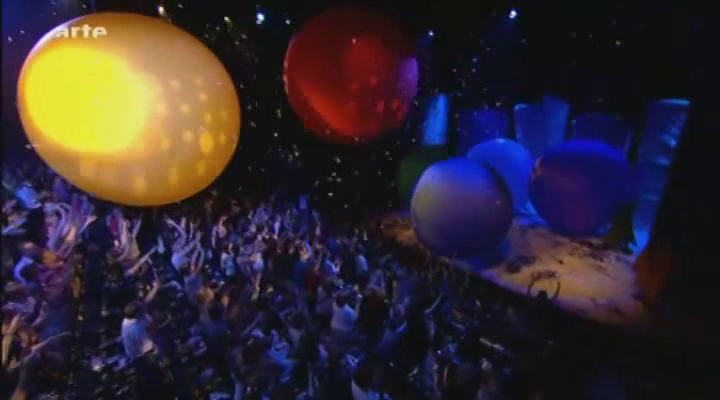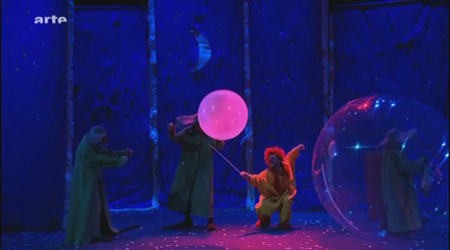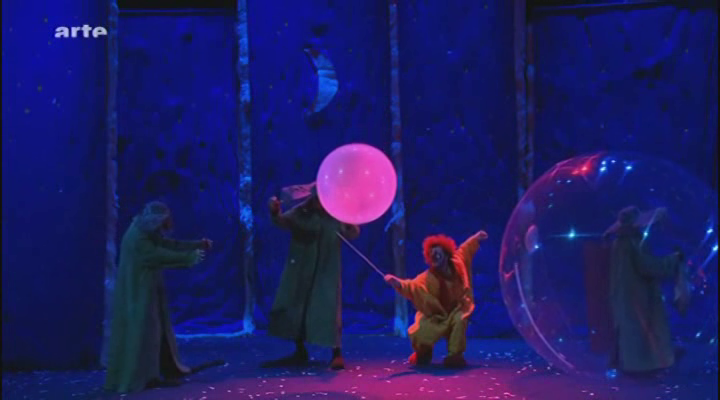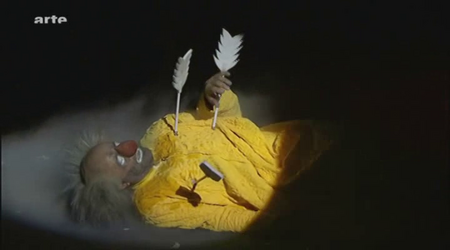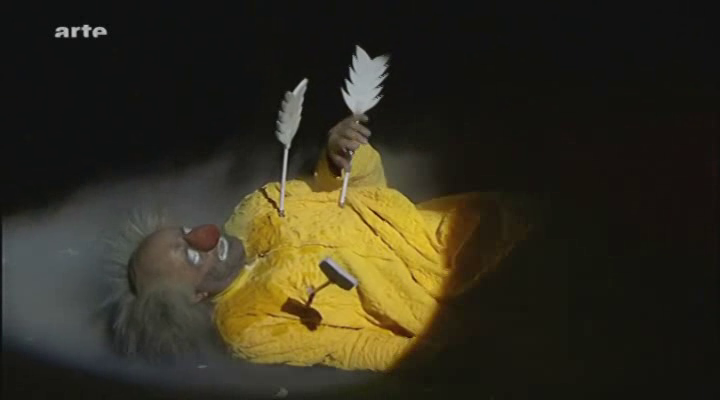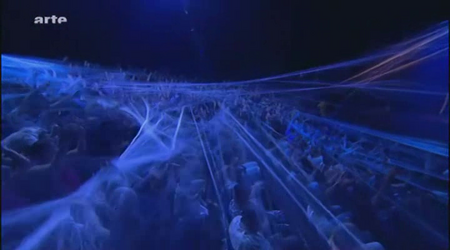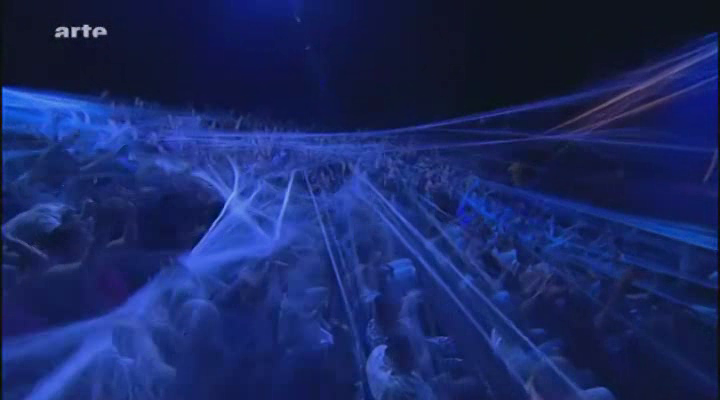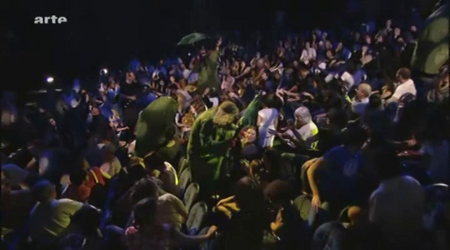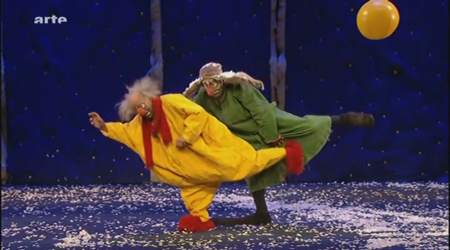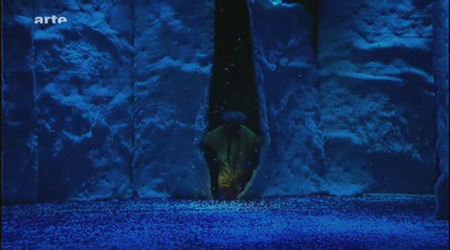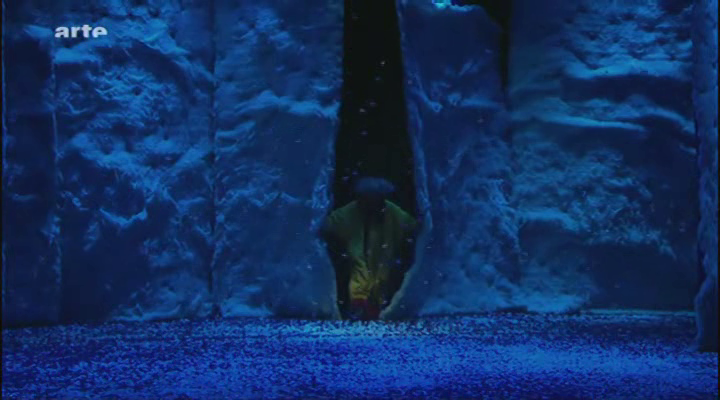(Arte) Slava's Snowshow : The Best Clown Show in the World (2010)
All Languages (No Dialogue) | 59:59 | 720 x 400 | 25fps | Avi Xvid MPEG-4 922 Kbps | MP3 116 Kbps | 445 MB
Genre: Art, Shows/Spectacles
All Languages (No Dialogue) | 59:59 | 720 x 400 | 25fps | Avi Xvid MPEG-4 922 Kbps | MP3 116 Kbps | 445 MB
Genre: Art, Shows/Spectacles
Bienvenue dans le monde de Slava Polunin. Fondateur du Licedeï, grand clown russe contemporain, Slava emprunte sa gestuelle à Marceau et à Chaplin. C'est un poète, amoureux du public. "Mes spectacles ont du succès parce que je ne les joue pas, je les vis", dit-il. De Hong-Kong à Sydney en passant par New York, son Snowshow, événement visuel et musical, fait pleurer de joie le monde entier. Ce spectacle où chaque scène a la grâce d'un tableau raconte l'épopée absurde d'un "commando" de quinze clowns au nez rouge. Bulles de savon, tempête de neige, créatures vertes aux longs chapeaux, corde de pendu transformée en fil d'Ariane, esquif en perdition dans une mer agitée, requin improbable pris dans des eaux brumeuses, clowns et public en lutte avec une gigantesque toile d'araignée, vrai-faux entracte, adieux déchirants à un portemanteau… : on n'en finit pas d'égrener les joyaux de cet univers poétique. Quant au surprenant final, chut…
They call him "the best clown in the world". His Snow Show is celebrated as "a theatre classic of the 20th century" (The Times, London). Recognition came unusually early for Slava Polunin, and from that moment on, his fame was unstoppable. This is probably because Slava doesn't do things "just like that". Everything in his life is very well considered, very finely weighed - even the most crazy, the most incredible, the most adventurous of feats. In achieving his aims, he is concrete, collected and imperturbable.
Evidently he was always like this. As when he left his native Novosil, a little town in the Orlovsk province, to see the most beautiful city in the world, as he imagined Leningrad through his geography teacher's tales. Or, as when he quit the Engineering-Economic Institute in that same Leningrad, regardless of Mama's dreams to see him as an engineer. Or indeed as when, almost wholly independently, he started working in pantomime, that intriguing art of secrets and the ineffable.
His eccentric pantomime, which he lovingly dubbed "Expressive Idiotism", brought him enormous popularity. It also crowned him an artist laureate of Estrada, the Russian showbiz stage. There wasn't a single concert of note in which the double-act Polunin-Skorzov didn't play a part.
Only a year went by and Polunin's famous clown, Asisyai, was born: a humorous and touching figure in a yellow boiler suit and red fluffy slippers. This thoughtful, gentle, poetic character came into the world drawing on the poetic sadness of Leonid Engibarov's clownery, the refined philosophising of Marcel Marceau's pantomime, and the humanity and comic poignancy of great Chaplin's films. All of these Polunin considers his major teachers.
Asisyai first appeared before an audience of millions of television viewers in the new year's edition of "Light Blue Flame" in 1980-1981, in a sketch with two oversized inflatable telephones. Here for the first time was heard his dialogue on love, on loneliness, on the longing for human understanding, on the bliss of discovery and the bitterness of loss, which to this day accompanies Polunin's hero - and the clown himself - to his audiences in the most diverse corners of our planet.
Originally Asisyai was many-faced and multi-facetted: he could be gentle and na?ve, but ironic the next minute, or puffed up in full-blown conviction, emitting his invincible "Zya!". So the thought arose, that each facet of his character could grow into a separate personage. This is how the idea for a theatre of clowns was born, where each is different from every other, but recognisable and familiar to every single member of the audience. This kaleidoscope of characters came to fruition in a renewal of his Licedei, a theatre founded by Polunin himself, whose last curtain was only to fall in 1992. The Licedei was so stunningly popular that the force of the entire country's love for it began to take on a threatening dimension. It might have seemed the time to rest on his laurels, but it is precisely this that Polunin is incapable of. Slava was determined to use this nationwide popular devotion to purposeful ends, and began, step by step, to bring to life the most unbelievable and courageous projects.
The first of these was the Mime-Parade of 1982, to which flocked more than 800 pantomime artists from every corner of our then still very far-flung country. Next, already as early as 1985, Polunin found the courage to take a glimpse beyond the Iron Curtain, to cut a window into it - and not only for himself, but for his Moscow audience. For in that year, for the first time, he brought foreign mimes and clowns to Moscow for a festival organised in the context of the World Gathering of Youth and Students. Polunin next felt the need to not only work in street theatre himself, but to captivate with this idea those freshly-baked clowns his gentle hand had only recently recruited to clownery from pantomime. That was in 1987, at the first festival of street theatre called Licedei- Lyc?e. A year later, it was decided to celebrate the twentieth anniversary of the Licedei with an All-Union Congress of Fools. The latter event was not only a festival of clown theatre, but became the festive funeral for the Licedei theatre itself - for, as Stanislavsky had asserted, a theatre dies after 20 years of life. Not wishing to argue with the classics, they put coffins on stage and invited their dearest guests to attend the requiem. All was done with great dignity and honour: the mournful birthday congratulations, the many-thousand strong procession through the streets, and finally, the ceremonious floating of the burning coffins down Leningrad's (now St. Petersburg's) broad Neva river.
The apotheosis in matters of making the impossible possible, and realising the unrealisable was the Mir Caravan (Caravan of Peace) - a traveling festival of theatre which wheeled its way across Europe, from Moscow to Paris, in the course of half a year. The artists lived in camper vans, performed in the streets and under the circus flaps. A grand composition of theaters from Russia, France, Italy, Spain, the Czech Republic and Poland, they made up an epochal canvas, a veritable Odyssey, and almost went mad from the novelty and intractability of it all, from what surrounded them, and from their incessant public life. And thus, in 1989, three months before the fall of the Berlin wall, the participants of the Caravan independently upended all borders in Europe - if only for a limited contingent of artists. Europe didn't wait for long, but followed in their tracks to actively unite!
Next to be founded was the Academy of Fools. Within only a couple of years of activity on Russian soil, this was able to countenance the problem of the rebirth of the idea of carnival: a carnival of the new, of the contemporary - not of the reconstructed kind, not of the museum. In that year, in 1993, the first fumbling steps where taken towards that road, along which they would later broadly stride, to eventually unfurl the so-called New Carnival in the framework of the World Theatre Olympics, in Moscow's Hermitage Gardens in the summer of 2001.
First, however, the Academy of Fools introduced a festival with the typically Russian name of Baby-Dury (the Crazy Women Festival), which was dedicated to the rare natural occurrence of female clownery. The new expanded version of this festival still awaits realization under new historical conditions. But at the time the veteran guild of fools under the leadership of Rolan Bykov frolicked and wreaked havoc in Moscow, bestowing the titles of "Total Idiot" and "Half-wit" to the best of the best, and also giving welcome to great fools from abroad. Many years later Polunin brought these very same luminaries together for the Theatre Olympics in Moscow, all in the context of another one of his programmes called The Twentieth Century's Best Clowns. It was then, truly, that the Russian capital became host to the peerless - the maddest and the wisest - Boleslav Polivka, Jerome Deschamp, Franz-Joseph Bogner, Django Edwards and Leo Bassi.
Between 1993 and the projects of the Theatre Olympics of 2001, when Polunin's name was once again on everyone's lips in Russia, the years passed by with work in other countries: the never ending world tour of Slava's famous Snow Show, which continues to this day. In the course of its travels, it has been awarded a plethora of prestigious prizes, and smothered in popular adoration and the exuberant reception of critics.
Once a Canadian lady sent Slava a little note after the show: "Your snow warms our hearts. Thank you." And indeed, Polunin's "snow storm " keeps warming our hearts with its snowy tenderness.
Evidently he was always like this. As when he left his native Novosil, a little town in the Orlovsk province, to see the most beautiful city in the world, as he imagined Leningrad through his geography teacher's tales. Or, as when he quit the Engineering-Economic Institute in that same Leningrad, regardless of Mama's dreams to see him as an engineer. Or indeed as when, almost wholly independently, he started working in pantomime, that intriguing art of secrets and the ineffable.
His eccentric pantomime, which he lovingly dubbed "Expressive Idiotism", brought him enormous popularity. It also crowned him an artist laureate of Estrada, the Russian showbiz stage. There wasn't a single concert of note in which the double-act Polunin-Skorzov didn't play a part.
Only a year went by and Polunin's famous clown, Asisyai, was born: a humorous and touching figure in a yellow boiler suit and red fluffy slippers. This thoughtful, gentle, poetic character came into the world drawing on the poetic sadness of Leonid Engibarov's clownery, the refined philosophising of Marcel Marceau's pantomime, and the humanity and comic poignancy of great Chaplin's films. All of these Polunin considers his major teachers.
Asisyai first appeared before an audience of millions of television viewers in the new year's edition of "Light Blue Flame" in 1980-1981, in a sketch with two oversized inflatable telephones. Here for the first time was heard his dialogue on love, on loneliness, on the longing for human understanding, on the bliss of discovery and the bitterness of loss, which to this day accompanies Polunin's hero - and the clown himself - to his audiences in the most diverse corners of our planet.
Originally Asisyai was many-faced and multi-facetted: he could be gentle and na?ve, but ironic the next minute, or puffed up in full-blown conviction, emitting his invincible "Zya!". So the thought arose, that each facet of his character could grow into a separate personage. This is how the idea for a theatre of clowns was born, where each is different from every other, but recognisable and familiar to every single member of the audience. This kaleidoscope of characters came to fruition in a renewal of his Licedei, a theatre founded by Polunin himself, whose last curtain was only to fall in 1992. The Licedei was so stunningly popular that the force of the entire country's love for it began to take on a threatening dimension. It might have seemed the time to rest on his laurels, but it is precisely this that Polunin is incapable of. Slava was determined to use this nationwide popular devotion to purposeful ends, and began, step by step, to bring to life the most unbelievable and courageous projects.
The first of these was the Mime-Parade of 1982, to which flocked more than 800 pantomime artists from every corner of our then still very far-flung country. Next, already as early as 1985, Polunin found the courage to take a glimpse beyond the Iron Curtain, to cut a window into it - and not only for himself, but for his Moscow audience. For in that year, for the first time, he brought foreign mimes and clowns to Moscow for a festival organised in the context of the World Gathering of Youth and Students. Polunin next felt the need to not only work in street theatre himself, but to captivate with this idea those freshly-baked clowns his gentle hand had only recently recruited to clownery from pantomime. That was in 1987, at the first festival of street theatre called Licedei- Lyc?e. A year later, it was decided to celebrate the twentieth anniversary of the Licedei with an All-Union Congress of Fools. The latter event was not only a festival of clown theatre, but became the festive funeral for the Licedei theatre itself - for, as Stanislavsky had asserted, a theatre dies after 20 years of life. Not wishing to argue with the classics, they put coffins on stage and invited their dearest guests to attend the requiem. All was done with great dignity and honour: the mournful birthday congratulations, the many-thousand strong procession through the streets, and finally, the ceremonious floating of the burning coffins down Leningrad's (now St. Petersburg's) broad Neva river.
The apotheosis in matters of making the impossible possible, and realising the unrealisable was the Mir Caravan (Caravan of Peace) - a traveling festival of theatre which wheeled its way across Europe, from Moscow to Paris, in the course of half a year. The artists lived in camper vans, performed in the streets and under the circus flaps. A grand composition of theaters from Russia, France, Italy, Spain, the Czech Republic and Poland, they made up an epochal canvas, a veritable Odyssey, and almost went mad from the novelty and intractability of it all, from what surrounded them, and from their incessant public life. And thus, in 1989, three months before the fall of the Berlin wall, the participants of the Caravan independently upended all borders in Europe - if only for a limited contingent of artists. Europe didn't wait for long, but followed in their tracks to actively unite!
Next to be founded was the Academy of Fools. Within only a couple of years of activity on Russian soil, this was able to countenance the problem of the rebirth of the idea of carnival: a carnival of the new, of the contemporary - not of the reconstructed kind, not of the museum. In that year, in 1993, the first fumbling steps where taken towards that road, along which they would later broadly stride, to eventually unfurl the so-called New Carnival in the framework of the World Theatre Olympics, in Moscow's Hermitage Gardens in the summer of 2001.
First, however, the Academy of Fools introduced a festival with the typically Russian name of Baby-Dury (the Crazy Women Festival), which was dedicated to the rare natural occurrence of female clownery. The new expanded version of this festival still awaits realization under new historical conditions. But at the time the veteran guild of fools under the leadership of Rolan Bykov frolicked and wreaked havoc in Moscow, bestowing the titles of "Total Idiot" and "Half-wit" to the best of the best, and also giving welcome to great fools from abroad. Many years later Polunin brought these very same luminaries together for the Theatre Olympics in Moscow, all in the context of another one of his programmes called The Twentieth Century's Best Clowns. It was then, truly, that the Russian capital became host to the peerless - the maddest and the wisest - Boleslav Polivka, Jerome Deschamp, Franz-Joseph Bogner, Django Edwards and Leo Bassi.
Between 1993 and the projects of the Theatre Olympics of 2001, when Polunin's name was once again on everyone's lips in Russia, the years passed by with work in other countries: the never ending world tour of Slava's famous Snow Show, which continues to this day. In the course of its travels, it has been awarded a plethora of prestigious prizes, and smothered in popular adoration and the exuberant reception of critics.
Once a Canadian lady sent Slava a little note after the show: "Your snow warms our hearts. Thank you." And indeed, Polunin's "snow storm " keeps warming our hearts with its snowy tenderness.
Его называют «лучшим клоуном мира». Его «сНЕЖНОЕ шоу» признано «театральной классикой ХХ века».
Когда его спрашивают, легко ли нести бремя всемирной славы, Слава обычно отвечает, что нести, мол, ничего, а вот удержать… Наверное, поэтому ничего не делает абы как: все, что происходит в его жизни, очень основательно, очень продумано, очень взвешено – даже самое сумасшедшее, самое невероятное, самое авантюрное. И в достижении цели он конкретен, собран и непоколебим.
Так было, видимо, всегда : и когда он покинул родной Новосиль, маленький городок в Орловской области, чтобы увидеть самый красивый город на свете, каковым представлялся ему по рассказам его учительницы географии Ленинград. И когда бросил в том Ленинграде энергетический институт, несмотря на то, что мама мечтала видеть его инженером. И когда стал заниматься практически самостоятельно загадочным, полным тайн и недосказанности искусством пантомимы.
Эксцентрическая пантомима, любовно окрещенная им «экспрессивным идиотизмом», принесла ему огромную популярность – не было ни одного значимого концерта, в котором дуэт Полунин-Скворцов не принимал бы участия. Она же принесла ему и лауреатство на конкурсе артистов эстрады.
А уже через год родился его Клоун, его Асисяй – смешной и трогательный человечек в желтом комбинезоне и красных лохматых тапочках. Родился задумчивый, нежный, поэтичный персонаж, характер которого вобрал в себя поэтическую грусть клоунад Енгибарова, изысканную философичность пантомим Марсо, человечность и смешную трогательность фильмов великого Чаплина. Всех их Полунин считает своими главными учителями.
Появился Асисяй перед многомиллионной аудиторией телезрителей в новогоднем «Голубом огоньке» на рубеже 80 и 81 года с двумя яркими надувными телефонами. Тогда и прозвучал впервые его диалог о любви, об одиночестве, о тоске по человеческому пониманию, о счастье обретения и горечи утраты, который и по сей день ведет герой Полунина с самим собой, а клоун - со своими зрителями в самых разных уголках планеты. Асисяй изначально был многолик и многогранен : он мог быть нежным и наивным, а в следующую минуту – ироничным или полным решимости в своем непоколебимом «Зя!». И тогда возникла мысль, что каждая из граней его характера может вырасти в отдельный персонаж.
Так родилась идея создания театра клоунов, где каждый не похож на другого, но узнаваем и хорошо знаком любому сидящему в зале. Этот калейдоскоп характеров и воплотился в «Лицедеях», театре, который Полунин создал и с которым проработал до начала девяностых годов. Популярность «Лицедеев» была оглушительной, а всенародная любовь начинала принимать угрожающий размах и формы. Казалось бы, настал момент почивать на лаврах, но этого как раз Полунин и не умеет. Всенародную любовь решено было использовать в мирных целях, и Слава стал постепенно претворять в жизнь самые немыслимые и более чем смелые проекты.
Первым из них был «Мим-парад» 1982 года, на который съехалось более 800 артистов пантомимы со всех концов тогда еще очень обширной родины. Потом, уже в 85 году, Полунин набрался смелости заглянуть за железный занавес и прорубить в нем брешь не только для себя, но и для московской публики – тогда он привез впервые иностранных мимов и клоунов на фестиваль в рамках Всемирного слета молодежи и студентов. Потом ему понадобилось не просто самому заняться уличным театром, но и увлечь этой идеей новоиспеченных клоунов, совсем еще недавно рекрутированных в клоунаду из пантомимы с его же легкой руки. Это было в 1987 году на первом фестивале уличных театров, который назывался «Лицедей-лицей». А год спустя решено было отметить двадцатилетие «Лицедеев» Всесоюзным «Конгрессом дураков». Сие мероприятие стало не просто фестивалем театров клоунады, но и торжественными похоронами театра «Лицедеи», ибо, как утверждал Станиславский, театр через 20 лет своего существования умирает. С классиком спорить не стали и выставили на сцену гробы, а на панихиду пригласили самых дорогих гостей . Все было честь по чести: траурные поздравления с днем рождения, многотысячное шествие по улице и, наконец, торжественный сплав горящих гробов по Неве.
Апофеозом в деле осуществления неосуществимого и реализации нереализуемого стал «Караван мира» - странствующий театральный фестиваль, колесивший на машинах по Европе от Москвы до Парижа в течение полугода. Артисты жили в домиках на колесах, играли на улице и в шапито, создали силами театров из России, Франции, Италии, Испании, Чехии, Польши совместное эпохальное полотно «Одиссея», чуть не сошли с ума от новизны и неизведанности всего того, что их окружало, и постоянной публичности жизни. В общем, в 1989 году , за три месяца до падения Берлинской стены, участники Каравана самостоятельно снесли все границы внутри Европы – пусть сначала только для ограниченного контингента артистов. Европа не заставила себя долго ждать и стала следом активно объединяться!
А потом была создана «Академия дураков», которая всего за пару лет своего активного существования на российской почве сумела обратиться и к проблеме возрождения идеи карнавала, но карнавала нового, современного, а не реконструированного, музейного. Тогда, в 93 году, были предприняты первые шаги на ощупь в этом направлении, чтобы позже двинуться по найденной дороге широким маршем и развернуть «новый карнавал» в рамках Всемирной Театральной Олимпиады в московском саду Эрмитаж летом 2001 года.
«Академией дураков» впервые был проведен фестиваль с типично русским названием «Бабы-дуры», посвященный редчайшему в природе явлению женской клоунады. Новая дополненная версия этого фестиваля еще ждет своей реализации в новых исторических условиях. А тогда гильдия старых дураков под предводительством Ролана Быкова по-своему бесчинствовала в Москве, раздавая титулы «полных дураков» и «полудурков» лучшим из лучших, и с удовольствием принимая в свои ряды великих дураков зарубежья. Их-то и собрал Полунин много лет спустя на Театральную Олимпиаду в Москву в рамках еще одной программы, названной «Лучшие клоуны конца ХХ века». В российскую столицу и вправду приехали лучшие – безумнейшие и мудрейшие – Болеслав Поливка, Жером Дешамп, Франц Йозеф Богнер, Джанго Эдвардс и Лео Басси.
Между 93 годом и проектами в рамках Театральной Олимпиады 2001, когда имя Полунина вновь стало на слуху у всех и каждого в России, пролегали годы работы в других странах – бесконечное турне по миру со знаменитым «сНЕЖНЫМ шоу», продолжающееся и по сей день. В ходе этого турне он получил множество престижных театральных премий, был обласкан зрительской любовью и восторженным отношением критики.
Однажды какая-то канадская зрительница написала ему после спектакля записочку: «Ваш снег согревает наши сердца. Спасибо.» Полунинская «Снежная буря» согревает наши сердца своей удивительной «снежной нежностью»!
Когда его спрашивают, легко ли нести бремя всемирной славы, Слава обычно отвечает, что нести, мол, ничего, а вот удержать… Наверное, поэтому ничего не делает абы как: все, что происходит в его жизни, очень основательно, очень продумано, очень взвешено – даже самое сумасшедшее, самое невероятное, самое авантюрное. И в достижении цели он конкретен, собран и непоколебим.
Так было, видимо, всегда : и когда он покинул родной Новосиль, маленький городок в Орловской области, чтобы увидеть самый красивый город на свете, каковым представлялся ему по рассказам его учительницы географии Ленинград. И когда бросил в том Ленинграде энергетический институт, несмотря на то, что мама мечтала видеть его инженером. И когда стал заниматься практически самостоятельно загадочным, полным тайн и недосказанности искусством пантомимы.
Эксцентрическая пантомима, любовно окрещенная им «экспрессивным идиотизмом», принесла ему огромную популярность – не было ни одного значимого концерта, в котором дуэт Полунин-Скворцов не принимал бы участия. Она же принесла ему и лауреатство на конкурсе артистов эстрады.
А уже через год родился его Клоун, его Асисяй – смешной и трогательный человечек в желтом комбинезоне и красных лохматых тапочках. Родился задумчивый, нежный, поэтичный персонаж, характер которого вобрал в себя поэтическую грусть клоунад Енгибарова, изысканную философичность пантомим Марсо, человечность и смешную трогательность фильмов великого Чаплина. Всех их Полунин считает своими главными учителями.
Появился Асисяй перед многомиллионной аудиторией телезрителей в новогоднем «Голубом огоньке» на рубеже 80 и 81 года с двумя яркими надувными телефонами. Тогда и прозвучал впервые его диалог о любви, об одиночестве, о тоске по человеческому пониманию, о счастье обретения и горечи утраты, который и по сей день ведет герой Полунина с самим собой, а клоун - со своими зрителями в самых разных уголках планеты. Асисяй изначально был многолик и многогранен : он мог быть нежным и наивным, а в следующую минуту – ироничным или полным решимости в своем непоколебимом «Зя!». И тогда возникла мысль, что каждая из граней его характера может вырасти в отдельный персонаж.
Так родилась идея создания театра клоунов, где каждый не похож на другого, но узнаваем и хорошо знаком любому сидящему в зале. Этот калейдоскоп характеров и воплотился в «Лицедеях», театре, который Полунин создал и с которым проработал до начала девяностых годов. Популярность «Лицедеев» была оглушительной, а всенародная любовь начинала принимать угрожающий размах и формы. Казалось бы, настал момент почивать на лаврах, но этого как раз Полунин и не умеет. Всенародную любовь решено было использовать в мирных целях, и Слава стал постепенно претворять в жизнь самые немыслимые и более чем смелые проекты.
Первым из них был «Мим-парад» 1982 года, на который съехалось более 800 артистов пантомимы со всех концов тогда еще очень обширной родины. Потом, уже в 85 году, Полунин набрался смелости заглянуть за железный занавес и прорубить в нем брешь не только для себя, но и для московской публики – тогда он привез впервые иностранных мимов и клоунов на фестиваль в рамках Всемирного слета молодежи и студентов. Потом ему понадобилось не просто самому заняться уличным театром, но и увлечь этой идеей новоиспеченных клоунов, совсем еще недавно рекрутированных в клоунаду из пантомимы с его же легкой руки. Это было в 1987 году на первом фестивале уличных театров, который назывался «Лицедей-лицей». А год спустя решено было отметить двадцатилетие «Лицедеев» Всесоюзным «Конгрессом дураков». Сие мероприятие стало не просто фестивалем театров клоунады, но и торжественными похоронами театра «Лицедеи», ибо, как утверждал Станиславский, театр через 20 лет своего существования умирает. С классиком спорить не стали и выставили на сцену гробы, а на панихиду пригласили самых дорогих гостей . Все было честь по чести: траурные поздравления с днем рождения, многотысячное шествие по улице и, наконец, торжественный сплав горящих гробов по Неве.
Апофеозом в деле осуществления неосуществимого и реализации нереализуемого стал «Караван мира» - странствующий театральный фестиваль, колесивший на машинах по Европе от Москвы до Парижа в течение полугода. Артисты жили в домиках на колесах, играли на улице и в шапито, создали силами театров из России, Франции, Италии, Испании, Чехии, Польши совместное эпохальное полотно «Одиссея», чуть не сошли с ума от новизны и неизведанности всего того, что их окружало, и постоянной публичности жизни. В общем, в 1989 году , за три месяца до падения Берлинской стены, участники Каравана самостоятельно снесли все границы внутри Европы – пусть сначала только для ограниченного контингента артистов. Европа не заставила себя долго ждать и стала следом активно объединяться!
А потом была создана «Академия дураков», которая всего за пару лет своего активного существования на российской почве сумела обратиться и к проблеме возрождения идеи карнавала, но карнавала нового, современного, а не реконструированного, музейного. Тогда, в 93 году, были предприняты первые шаги на ощупь в этом направлении, чтобы позже двинуться по найденной дороге широким маршем и развернуть «новый карнавал» в рамках Всемирной Театральной Олимпиады в московском саду Эрмитаж летом 2001 года.
«Академией дураков» впервые был проведен фестиваль с типично русским названием «Бабы-дуры», посвященный редчайшему в природе явлению женской клоунады. Новая дополненная версия этого фестиваля еще ждет своей реализации в новых исторических условиях. А тогда гильдия старых дураков под предводительством Ролана Быкова по-своему бесчинствовала в Москве, раздавая титулы «полных дураков» и «полудурков» лучшим из лучших, и с удовольствием принимая в свои ряды великих дураков зарубежья. Их-то и собрал Полунин много лет спустя на Театральную Олимпиаду в Москву в рамках еще одной программы, названной «Лучшие клоуны конца ХХ века». В российскую столицу и вправду приехали лучшие – безумнейшие и мудрейшие – Болеслав Поливка, Жером Дешамп, Франц Йозеф Богнер, Джанго Эдвардс и Лео Басси.
Между 93 годом и проектами в рамках Театральной Олимпиады 2001, когда имя Полунина вновь стало на слуху у всех и каждого в России, пролегали годы работы в других странах – бесконечное турне по миру со знаменитым «сНЕЖНЫМ шоу», продолжающееся и по сей день. В ходе этого турне он получил множество престижных театральных премий, был обласкан зрительской любовью и восторженным отношением критики.
Однажды какая-то канадская зрительница написала ему после спектакля записочку: «Ваш снег согревает наши сердца. Спасибо.» Полунинская «Снежная буря» согревает наши сердца своей удивительной «снежной нежностью»!
~ Interchangeable Links ~
Un merci ?




